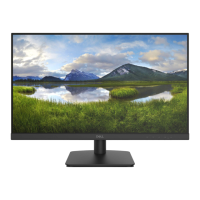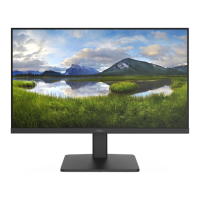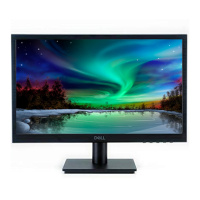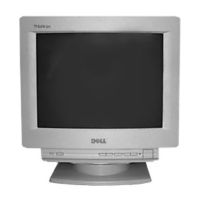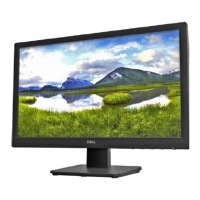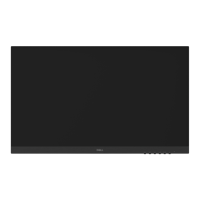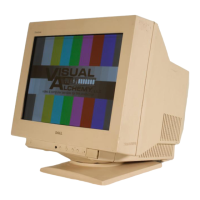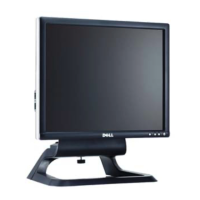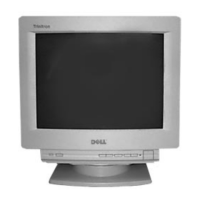Do you have a question about the Dell D7523QT and is the answer not in the manual?
Lists all items included in the monitor package for user verification.
Details the monitor's key features and capabilities, including display technology and connectivity options.
Identifies and describes the buttons, ports, and indicators on the front of the monitor.
Details the ports and mounting holes located on the back and side panels of the monitor.
Illustrates and describes the ports and connectors found on the bottom edge of the monitor.
Lists technical specifications such as screen type, aspect ratio, resolution, and response time.
Details supported resolutions, scan ranges, and video modes for optimal display performance.
Provides a table of preset display modes with corresponding horizontal, vertical frequencies, and pixel clock.
Outlines electrical input signals, voltage, current, and power consumption details for the monitor.
Specifies the physical dimensions, weight with and without packaging, and signal cable types.
Details environmental operating conditions, compliant standards, and thermal dissipation.
Provides pin assignments for the RJ45 and HDMI connectors on the monitor.
Details the pin configurations for the DisplayPort and USB connectors.
Lists pin assignments and communication settings for the RS232 serial port.
Explains the monitor's plug-and-play functionality for automatic system configuration.
Informs about the LCD monitor manufacturing process regarding pixels and the quality policy.
Provides step-by-step instructions for connecting the monitor to a computer.
Details the process for mounting a Dell Optiplex computer using a VESA mount.
Provides instructions and safety notes for mounting the monitor to a wall using a VESA bracket.
Details the buttons on the remote control and their respective functions for monitor operation.
Instructions for safely inserting and replacing batteries in the remote control.
Specifies the optimal distance and angle for using the remote control with the monitor.
Instructions on how to turn the monitor on and the initial setup process.
Overview of the Home Launcher, the main interface after initial setup.
Describes the functions available through the shortcut panel for quick access to features.
Explains how to set the date, time, and time zone on the monitor.
Details how to use the compass feature, including gestures and shortcuts.
Explains how to show, hide, and navigate through the monitor's sidebar menu.
Guides through configuring network settings, including IP address and connection methods.
Covers compass auto-fold options and adjusting audio volume and display brightness.
Explains how to customize input names and switch between different sources.
Details automatic date/time synchronization, time formats, and language selection.
Configures power states, no signal actions, and sleep/wake-up behaviors.
Covers system software updates and performing a factory reset.
Displays information about the monitor, including name, storage, MAC address, and OSS licenses.
Explains how to manage files on the monitor, including copy, paste, delete, and sort.
Details how to view and switch between different input sources like HDMI and DisplayPort.
Describes accessing tools like Ethernet and system apps like Montage/Broadcast.
Provides options for system standby, sleep mode, and rebooting the monitor.
Guides on setting the maximum display resolution in Windows 8.1, 10, and 11.
Lists necessary firewall ports and protocols for remote connections and network services.
Details proxy support types and network requirements for broadcast functionality.
Provides contact information and links for technical support for DisplayNote applications.
Offers solutions for common monitor issues like no video, poor focus, and jittery video.
Addresses issues like stuck pixels, brightness problems, geometric distortion, and missing color.
Provides solutions for product-specific issues such as small images or no input signal.
Details essential safety precautions, warnings, and regulatory compliance information.
Covers FCC compliance statements and other regulatory information for the device.
Provides contact methods for sales, technical support, and customer service issues with Dell.
Offers best practices for cleaning and maintaining the monitor's display and body.
Highlights notes on display damage from improper cleaning and warranty coverage.
Lists all items included in the monitor package for user verification.
Details the monitor's key features and capabilities, including display technology and connectivity options.
Identifies and describes the buttons, ports, and indicators on the front of the monitor.
Details the ports and mounting holes located on the back and side panels of the monitor.
Illustrates and describes the ports and connectors found on the bottom edge of the monitor.
Lists technical specifications such as screen type, aspect ratio, resolution, and response time.
Details supported resolutions, scan ranges, and video modes for optimal display performance.
Provides a table of preset display modes with corresponding horizontal, vertical frequencies, and pixel clock.
Outlines electrical input signals, voltage, current, and power consumption details for the monitor.
Specifies the physical dimensions, weight with and without packaging, and signal cable types.
Details environmental operating conditions, compliant standards, and thermal dissipation.
Provides pin assignments for the RJ45 and HDMI connectors on the monitor.
Details the pin configurations for the DisplayPort and USB connectors.
Lists pin assignments and communication settings for the RS232 serial port.
Explains the monitor's plug-and-play functionality for automatic system configuration.
Informs about the LCD monitor manufacturing process regarding pixels and the quality policy.
Provides step-by-step instructions for connecting the monitor to a computer.
Details the process for mounting a Dell Optiplex computer using a VESA mount.
Provides instructions and safety notes for mounting the monitor to a wall using a VESA bracket.
Details the buttons on the remote control and their respective functions for monitor operation.
Instructions for safely inserting and replacing batteries in the remote control.
Specifies the optimal distance and angle for using the remote control with the monitor.
Instructions on how to turn the monitor on and the initial setup process.
Overview of the Home Launcher, the main interface after initial setup.
Describes the functions available through the shortcut panel for quick access to features.
Explains how to set the date, time, and time zone on the monitor.
Details how to use the compass feature, including gestures and shortcuts.
Explains how to show, hide, and navigate through the monitor's sidebar menu.
Guides through configuring network settings, including IP address and connection methods.
Covers compass auto-fold options and adjusting audio volume and display brightness.
Explains how to customize input names and switch between different sources.
Details automatic date/time synchronization, time formats, and language selection.
Configures power states, no signal actions, and sleep/wake-up behaviors.
Covers system software updates and performing a factory reset.
Displays information about the monitor, including name, storage, MAC address, and OSS licenses.
Explains how to manage files on the monitor, including copy, paste, delete, and sort.
Details how to view and switch between different input sources like HDMI and DisplayPort.
Describes accessing tools like Ethernet and system apps like Montage/Broadcast.
Provides options for system standby, sleep mode, and rebooting the monitor.
Guides on setting the maximum display resolution in Windows 8.1, 10, and 11.
Lists necessary firewall ports and protocols for remote connections and network services.
Details proxy support types and network requirements for broadcast functionality.
Provides contact information and links for technical support for DisplayNote applications.
Offers solutions for common monitor issues like no video, poor focus, and jittery video.
Addresses issues like stuck pixels, brightness problems, geometric distortion, and missing color.
Provides solutions for product-specific issues such as small images or no input signal.
Details essential safety precautions, warnings, and regulatory compliance information.
Covers FCC compliance statements and other regulatory information for the device.
Provides contact methods for sales, technical support, and customer service issues with Dell.
Offers best practices for cleaning and maintaining the monitor's display and body.
Highlights notes on display damage from improper cleaning and warranty coverage.
| Hardness | 7H |
|---|---|
| Haze rate | 2 % |
| Panel type | VA |
| Color gamut | 72 % |
| Pixel pitch | 0.4296 x 0.4296 mm |
| Screen shape | Flat |
| LED backlight | Yes |
| Response time | 8 ms |
| RGB color space | NTSC |
| Display diagonal | 74.52 \ |
| Anti-glare screen | Always gives an optimal view, even in direct sunlight. |
| Display brightness | 430 cd/m² |
| Display technology | LCD |
| Native aspect ratio | 16:9 |
| Native refresh rate | 60 Hz |
| Vertical scan range | 23 - 75 Hz |
| Horizontal scan range | 30 - 160 kHz |
| Supported video modes | 480i, 480p, 576i, 576p, 720p, 1080i, 1080p, 2160p |
| Contrast ratio (typical) | 1200:1 |
| Display number of colors | 1.07 billion colors |
| Active display area (W x H) | 1649.664 x 927.936 mm |
| Supported graphics resolutions | 640 x 480 (VGA), 720 x 400, 800 x 600 (SVGA), 1024 x 768 (XGA), 1280 x 1024 (SXGA), 1600 x 900, 1920 x 1080 (HD 1080), 3840 x 2160 |
| RMS rated power | 24 W |
| Number of built-in speakers | 2 |
| Product color | Black |
| Product design | Interactive flat panel |
| Bezel width (top) | 16.3 mm |
| Placement supported | Indoor |
| Bezel width (bottom) | 54.3 mm |
| Panel mounting interface | 600 x 400 mm |
| Purpose | Universal |
| DVI port | No |
| USB version | 2.0/3.2 Gen 1 (3.1 Gen 1) |
| USB connector type | USB Type-A, USB Type-B |
| USB ports quantity | 6 |
| HDMI ports quantity | 3 |
| Depth | 106.55 mm |
| Width | 1715.46 mm |
| Height | 1031.74 mm |
| Weight | 56450 g |
| Built-in processor | - |
| Cable lock slot type | Kensington |
| AC input voltage | 100 - 240 V |
| AC input frequency | 50 - 60 Hz |
| Power consumption (max) | 245 W |
| Power consumption (off) | 0 W |
| Power consumption (standby) | 0.3 W |
| Power consumption (typical) | 147.5 W |
| Package weight | 69000 g |
| Operating altitude | 0 - 5000 m |
| Non-operating altitude | 5000 - 12192 m |
| Storage temperature (T-T) | -20 - 60 °C |
| Operating temperature (T-T) | 0 - 40 °C |
| Storage relative humidity (H-H) | 10 - 90 % |
| Operating relative humidity (H-H) | 10 - 80 % |
| Doesn't contain | Mercury |
| Sustainability certificates | RoHS |
| Cables included | AC, DisplayPort, HDMI, USB |
